Who’s Who in Newspapers? Joseph A. Turner edition…
February 23, 2018 by GuyHeilenman · Leave a Comment
The 4th installment of Who’s Who in Newspapers:
George Washington, Benjamin Franklin, Alexander Hamilton… Babe Ruth, Jesse Owens, Vince Lombardi… John Wayne, James Dean, Katharine Hepburn – these individuals, among many, are easily recognizable. However, there are quite a few historical figures who, while having adorned the pages of many a newspaper, are far from household names. Such is the case with Joseph A Turner. Who is he? What was he known for? When did he live?
Mr. Turner just happens to be the publisher of what is believed to be the only Confederate newspaper printed/published on a Southern Plantation: The Countryman. He was the owner of Turnwold Plantation, located about 9 miles from Eatonton, Georgia – of Chick-fil-A, J.C.H. (see below), and The Color Purple fame.
As if this distinction were not enough, he took on Joel Chandler Harris – the eventual famed author of the Uncle Remus, Br’er Rabbit, and Br’er Fox stories, as an apprentice at the age of 14 – and trained him to serve as the typesetter for the newspaper.
Whenever we post an installment of “Who’s Who in Newspapers,” we typically provide a link to a chronological listing of newspapers which have information regarding the notable person in question. In this case, however, the newspapers are extremely rare, and while we do (at the time of this post) have a handful of issues, in this instance our link simply goes to a sample issue of this title:
THE COUNTRYMAN, by Joseph A. Turner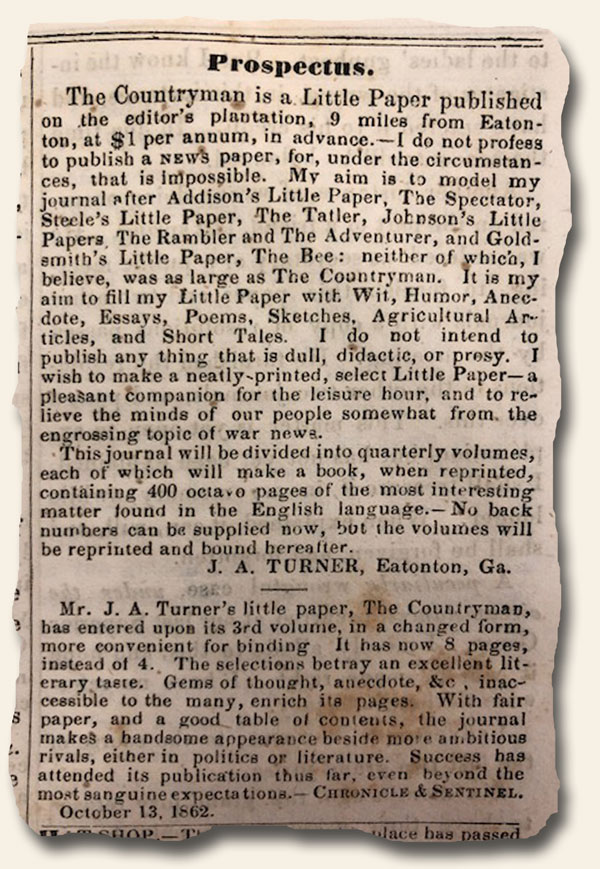
.
Who’s Who in Newspapers? P.T. Barnum edition…
January 25, 2018 by GuyHeilenman · Leave a Comment
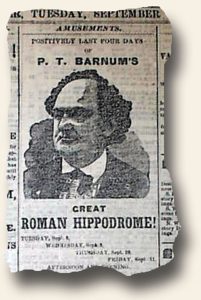 The 3rd installment of Wh0’s Who in Newspapers:
The 3rd installment of Wh0’s Who in Newspapers:
George Washington, Benjamin Franklin, Alexander Hamilton… Babe Ruth, Jesse Owens, Vince Lombardi… John Wayne, James Dean, Katharine Hepburn – these individuals among many are easily recognizable. However, there are quite a few historical figures who, while having adorned the pages of many a newspaper, are far from household names. Such is the case with Daniel Mendoza. Who is he? What was he known for? When did he live? These questions and more can be garnered through the newspapers of his day. Please enjoy the second installment of:
Who’s Who in Newspapers?
P.T. Barnum Edition
Note: As you explore this chronological set of newspapers, if duplicate issues appear for the same date, the item with the highest item # will have the most up-to-date information. While a few items may be available for sale, the purpose of this post is to introduce the reader to what can be found in historic newspapers.
The Traveler… up from the ashes…
April 17, 2017 by The Traveler · Leave a Comment
Today I traveled to New York City by the way of the Harper’s Weekly dated April 20, 1867. In the issue I found the reporting of the “Burning of the Lindell Hotel, at Saint Louis, Missouri,  March 30, 1867″. “…The Lindell is admitted to have been the largest building for purposes of accommodation ever erected in America. It was six stories high exclusive of attic and basement; and was divided into the five hundred and thirty rooms, and the largest of which was 116 by 44 feet. The actual cost of the building was $950,000, which, with the ground (valued at $326,400), makes the whole value $1, 276,400 — note to speak of furniture, $500,000 worth or which was imported… The efforts of the firemen were not relaxed, though it was evident that they would prove futile; the full force of the Department was steadily at work until 3 o’clock on the morning of March 31, at which time all the inner work was consume, and a considerable portion of the walls had fallen in, and the once imposing hotel was a mass of crumbling, blackened ruins.”
March 30, 1867″. “…The Lindell is admitted to have been the largest building for purposes of accommodation ever erected in America. It was six stories high exclusive of attic and basement; and was divided into the five hundred and thirty rooms, and the largest of which was 116 by 44 feet. The actual cost of the building was $950,000, which, with the ground (valued at $326,400), makes the whole value $1, 276,400 — note to speak of furniture, $500,000 worth or which was imported… The efforts of the firemen were not relaxed, though it was evident that they would prove futile; the full force of the Department was steadily at work until 3 o’clock on the morning of March 31, at which time all the inner work was consume, and a considerable portion of the walls had fallen in, and the once imposing hotel was a mass of crumbling, blackened ruins.”
Almost immediately, the citizens of Lindell began assembling to discuss the rebuilding of the hotel. New construction began in September of 1872 with the opening in September of 1874.
~The Traveler
Harper’s Weekly: a magazine or a newspaper?
December 12, 2016 by TimHughes · 4 Comments
I’ve always referred to it as a newspaper to distinguish it from their own sister publication “Harper’s New Monthly Magazine” which, being smaller, many more pages, and issued monthly, is 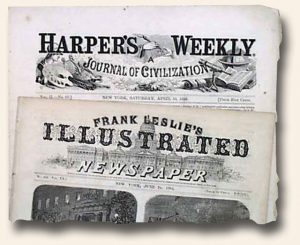 a more definitive magazine. Early in its history the weekly called themselves a “family newspaper”, and modeled themselves against “Frank Leslie’s Illustrated Newspaper” which began about a year earlier. If Leslie’s was a “newspaper” then certainly Harper’s Weekly was a “newspaper” as well.
a more definitive magazine. Early in its history the weekly called themselves a “family newspaper”, and modeled themselves against “Frank Leslie’s Illustrated Newspaper” which began about a year earlier. If Leslie’s was a “newspaper” then certainly Harper’s Weekly was a “newspaper” as well.
However, in Mott’s “History of American Magazines” he includes a section for Harper’s Weekly, as well as one for Leslie’s Illustrated Newspaper and other similar weeklies. Then he confuses the issue a bit more in the second volume of his book (pg. 43) by stating: “Half a dozen copiously illustrated weeklies of general appeal must be grouped separately. It would not be inappropriate to classify these periodicals as newspapers, since they all relied much upon the reporting of current events: indeed, one of them called itself a newspaper in its title. But they were all very much more than newspapers, and they placed the emphasis on features of appeal which belonged more characteristically to the magazine than to the newspaper–namely, pictures and belles-lettres…”.
The Traveler… “…I could see no promise in him…”
December 5, 2016 by The Traveler · Leave a Comment
Today I traveled to New York City by the means of Harper’s New Monthly Magazine dated December, 1866. I found the first appearance of Mark Twain in a national magazine with the publishing of “Forty-Three Days in an Open Boat. Compiled From Personal Diaries.”
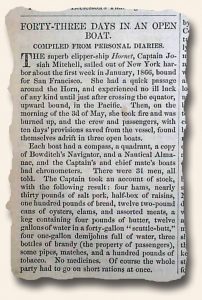 I also found through the Harper’s Monthly website the following information. “Mark Twain’s first article in Harper’s was miss-attributed to Mark Swain. The story, “Forty-three Days in an Open Boat” (December 1866), is an account of the Hornet, a clipper ship that caught fire in the ocean, leaving its crew adrift. Twain referred to it as the “first magazine article I ever published,” though he had published numerous pieces in other periodicals and newspapers under such names as Thomas Jefferson Snodgrass; W. Epaminondas Adrastus Blab; Rambler; Grumbler; and Peter Pencilcase’s Son, John Snooks.
I also found through the Harper’s Monthly website the following information. “Mark Twain’s first article in Harper’s was miss-attributed to Mark Swain. The story, “Forty-three Days in an Open Boat” (December 1866), is an account of the Hornet, a clipper ship that caught fire in the ocean, leaving its crew adrift. Twain referred to it as the “first magazine article I ever published,” though he had published numerous pieces in other periodicals and newspapers under such names as Thomas Jefferson Snodgrass; W. Epaminondas Adrastus Blab; Rambler; Grumbler; and Peter Pencilcase’s Son, John Snooks.
Mark Twain was born thirty-one years earlier, and two months premature, as Samuel Langhorne Clemens, in Florida, Missouri. “When I first saw him I could see no promise in him,” his mother said. The Clemenses moved several miles upstate, to the Missouri River-side Hannibal, when he was four; the town would later inspire the fictional St. Petersburg of his two most famous works, The Adventures of Tom Sawyer (1876) and The Adventures of Huckleberry Finn (1885)…”.
Twain didn’t turn out too bad after-all!
~The Traveler
The Traveler… giving thanks… not on the Sabbath…
October 17, 2016 by The Traveler · Leave a Comment
 I traveled to Boston today by the way of the Independent Chronicle dated October 14, 1816. I found “By His Excellency John Brooks, Governor of the Commonwealth of Massachusetts, A Proclamation, for a day of Public Thanksgiving and Prayer.” had been proclaimed. This was to be held on the Thursday, November 28.
I traveled to Boston today by the way of the Independent Chronicle dated October 14, 1816. I found “By His Excellency John Brooks, Governor of the Commonwealth of Massachusetts, A Proclamation, for a day of Public Thanksgiving and Prayer.” had been proclaimed. This was to be held on the Thursday, November 28.
Also found was an article entitled “Sabbath Laws” in which Judge Putnam “…repealed all former provisions upon the subject whether by statue or common law; that no act of labour, therefore, upon that day are lawful, except in cases of necessity or charity; and that prosecutions upon the statute are not within the exception…”. Too bad we cannot go back to those days…
~The Traveler
Early no-smoking cars on trains…
September 26, 2016 by TimHughes · Leave a Comment
 While the most significant feature of the “St. Louis Daily Globe” of February 2, 1875 is a report regarding Frank and Jesse James, the front page has a curious report headed: “A Peculiar Bill” concerning the need to create nonsmoking cars which would: “…afford relief to a great many ladies who are annoyed by cigar smoke, and other evils arising from the use of tobacco by gentlemen…” (see image).
While the most significant feature of the “St. Louis Daily Globe” of February 2, 1875 is a report regarding Frank and Jesse James, the front page has a curious report headed: “A Peculiar Bill” concerning the need to create nonsmoking cars which would: “…afford relief to a great many ladies who are annoyed by cigar smoke, and other evils arising from the use of tobacco by gentlemen…” (see image).
For whom the Baby Ruth candy bar was named…
September 12, 2016 by TimHughes · 2 Comments
The history of the origin of the name of the “Baby Ruth” candy bar by the Curtis Candy Company is interesting, brought to light recently with our finding the “Frank Leslie’s Illustrated” issue of Jan. 5, 1893. The full front page is an illustration captioned: “Baby Ruth and Her Mother” being the child of President Grover Cleveland. This is the person for whom the “Baby Ruth” candy bar was named, not Babe Ruth the famous baseball star as was popularly though. And the story behind the name is interesting.
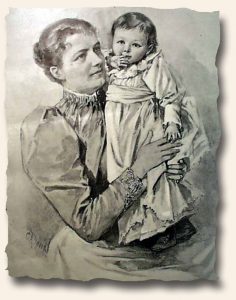 In Chicago in 1921 Otto Schnering had a turnaround plan for his Curtis Candy Company. He reformulated his “Kandy Kake” brand confection—a conglomeration of milk chocolate, peanuts and a pudding center “richer than marshmallow, fluffier than nougat, better than either of them”—into a chocolate-covered candy bar with peanuts, caramel and nougat. Along with the new recipe came a new name—Baby Ruth. At first glance, it seemed clear that Schnering had taken advantage of the home run king’s well-known name and tweaked it by one letter in order to avoid paying the “Sultan of Swat” any royalties.
In Chicago in 1921 Otto Schnering had a turnaround plan for his Curtis Candy Company. He reformulated his “Kandy Kake” brand confection—a conglomeration of milk chocolate, peanuts and a pudding center “richer than marshmallow, fluffier than nougat, better than either of them”—into a chocolate-covered candy bar with peanuts, caramel and nougat. Along with the new recipe came a new name—Baby Ruth. At first glance, it seemed clear that Schnering had taken advantage of the home run king’s well-known name and tweaked it by one letter in order to avoid paying the “Sultan of Swat” any royalties.
Perhaps because of its perceived connection to the Yankee slugger, Baby Ruth was a big success. By 1926, sales of the candy bar totaled $1 million a month, and the company’s candy-making facilities were the largest of their kind in the world.
In 1926, Ruth decided to enter the candy business himself and licensed his name to the George H. Ruth Candy Company, which sought to register “Ruth’s Home Run Candy” with the U.S. Patent and Trademark Office. Wrappers showed a head shot of a smiling Ruth in his uniform along with the note “Babe Ruth’s Own Candy.” The Curtiss Candy Company sued for copyright infringement and claimed that the candy bar had not been named after the baseball star, but Ruth Cleveland, eldest daughter of President Grover Cleveland. The explanation seemed odd given that the girl nicknamed “Baby Ruth” by the press had been born in 1891, three decades before the introduction of the candy bar. By 1921, not only was she not a baby, she wasn’t even alive, having died of diphtheria in 1904. Newspapers and the American public paid close attention to “Baby Ruth” after her father returned to the White House in 1893 for his second presidential term, but the Clevelands fiercely protected their daughter’s privacy and refused repeated requests by American newspapers to take her photograph. Few Americans ever knew what “Baby Ruth” looked like. By 1921, Babe Ruth was a household name while “Baby Ruth,” who died 17 years beforehand, was an historical footnote. (credit www.history.com)
Given the above, it is curious that this image of Baby Ruth Cleveland appeared on the front page of this very popular illustrated newspaper. Perhaps it is the only image of her in a newspaper.
A gem from the American Antiquarian Society… The Kentucky Spy…
August 8, 2016 by TimHughes · Leave a Comment
In celebration of its 20oth anniversary the American Antiquarian Society published a beautiful exhibition catalog titled “In Pursuit Of A Vision – Two Centuries of Collecting at the American Antiquarian Society”. Featured are a fascinating array of books, documents, maps & other paper ephemera, as well as several very rare & unusual newspapers we felt worthy of sharing with our collectors (with permission from the A.A.S.).
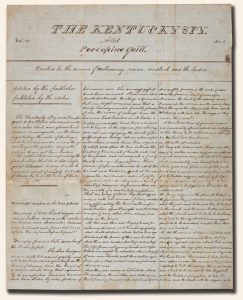 181. “The Kentucky Spy and Porcupine Quill“, Frankfort, Kentucky, January 25, 1849
181. “The Kentucky Spy and Porcupine Quill“, Frankfort, Kentucky, January 25, 1849
In recent years AAS has actively collected issues of pre-1877 American manuscript periodicals. These handwritten examples mimic printed periodicals in format and content, containing stories, news, and advertisements. Sometimes they were produced by individuals, serving as the manuscript equivalent of amateur newspapers, and sometimes they were issued by small groups. Others were produced as an activity of a school or lyceum.
AAS has held manuscript periodicals since the nineteenth century; but because these were long shelved alongside printed periodicals, they were easily overlooked. In the 1990s AAS staff began to pull them together into a separate collection, in the process discovering not only how many titles were already at AAS, but also the frequency with which they were produced. As it became apparent that the more specimens AAS had, the more they collectively revealed about early American scribal culture, AAS began to seek them actively. The collection now numbers more than sixty titles.
One of the more unusual is “The Kentucky Spy and Porcupine Quill.” The masthead claims that it is “Devoted to the science of matrimony, union, wedlock and the ladies.” However, the chief story, entitled “Wonderful rumpus in the town of Irvine,” is a fictional account, humorous in tone, of a revolt by 5,000 heavily armed slaves which in the story turns out to be a hoax. The editor and contributor(s) are unnamed.
The Traveler… Rabbi Gershom Seixas… 1st native-born American rabbi…
July 4, 2016 by The Traveler · Leave a Comment
Today I traveled back to New York City by the means of the New York Evening Post dated July 2, 1816. Under the “Died” column is “Departed this life, at 9 o’clock this morning, the Rev. Mr. GERSHOM SEIXAS, the venerable Pastor of the Hebrew congregation, in the 71st year of his age…”.
 Mr. Seixas was the first Native-born American rabbi. He also delivered the first Thanksgiving address in an American synagogue after the adoption of the United States Constitution. He was one of the fourteen ministers to participate in George Washington’s first inauguration.
Mr. Seixas was the first Native-born American rabbi. He also delivered the first Thanksgiving address in an American synagogue after the adoption of the United States Constitution. He was one of the fourteen ministers to participate in George Washington’s first inauguration.
At the merger of the 200th anniversary of his death and the 240th anniversary of the American Declaration of Independence it is fitting to consider how quickly the Jewish population became acclimated and accepted in the United States. While not without considerable bumps in the road, George Washington’s outspoken support for Jewish citizens was certainly a good beginning.
Question: Washington’s letter to the Hebrew Congregation in Newport, RI received a response from Rabbi Moses Seixas. If anyone can confirm whether or not Moses and Gershom were related, please contact Guy at guy@rarenewspapers.com.
~The Traveler


